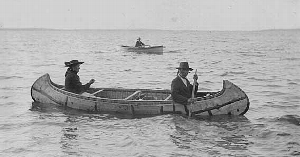There is no comparison to an evening paddle to an island in the middle of an Adirondack lake. With a shoreline campfire raging as the last rays of the sun pour across the water, and the cry of the loons and rustle of spruce needles on the wind, this sublime scenery is almost a dream. This iconic scene draws millions of visitors to the Adirondack State Park every year. The park has a long history of paddling, either for economic or tourism needs, and is essential to life in the park.
Paddling is engrained in the history of the Adirondack waterways — boats have been engineered specifically to maneuver these streams and lakes. The Iroquois and Algonquin Indian tribes inhabited the mountains of the Adirondacks for the past 5,000 years until the American Civil War, and have historically relied upon canoes made of spruce, elm, and birch bark to travel through the forest (Bond). To construct these vessels, boat makers peeled sheets of bark from trees, either in pieces large enough to form an entire hull, or in sections that were sewn together. The bottom of the bark was weighted into an earthen mold, and the sides were folded up. The entire canoe was supported with lashed wooden gunwales and thwarts in order to shape the boat. These canoes were light and agile, and were used to navigate the treacherous streams and ponds in the Adirondacks. The Native Americans also paddled in dugout canoes, which were carved from tree trunks. These were much heavier than bark canoes, and were therefore only used on the large bodies of water where they were originally carved. Both of these boats were used into the 19th century in the Adirondacks (Bond).

Paddlers in Bark Canoe (Minnesota Historical Society/Wikimedia)
In the 1820s, marine transportation was forever changed in the Adirondacks. While many people still relied on traditional canoes to navigate the narrows streams of the Adirondacks, the guideboat was the product of pure local ingenuity. Even though the guideboat was just as long and even wider than its predecessors, it was a much lighter weight since it was made of very thin long wooden planks 3/16 - 1/4 of an inch thick (Adirondack Guideboats). This revolutionary design created a very low weight to size ratio, making it much faster than a canoe even though it required only one person to row instead of two or more. Despite its large size, one person could easily carry a guideboat on his shoulders across land, allowing for access to remote crevices of the park.

Rower in Adirondack Guideboat (Kathleen Tyler Conklin/flickr)
The use of guideboats has changed very little over the past two centuries. While they were first used to transport goods between settlements in the park’s interior, the skiffs quickly became an ideal vessel for guides to show paying clients the Adirondack wilderness (Bond). The skiff was a major contributor to the success of the guiding industry, since it allowed the guide to row while the client leisurely sat and enjoyed the beauty of the park. Though Adirondack guideboats are no longer used to shuttle paying customers through the park, they are still used by residents and tourists as a mode of recreation.
The guideboat served as the backbone to the modern boating industry within the Adirondacks. While many of these vessels are still constructed by woodworking artisans within the park, modern industry has replaced much of the tradition and craftsmanship in order to save time and money. Canoes are now not only made of wood, but also of aluminum, thermoplastic, Kevlar, fiberglass, and carbon fiber. Though aluminum boats are just as heavy as those made of plastic, they are much more durable and do not crack as easily (paddling.net). The durability of both of these boats makes them ideal for rental to tourists, so those who are less experienced on the water can run them over a few rocks without it costing them thousands of dollars in damage. The difference in speed and weight between these three boat designs is so minute, however, that usually only racers and backcountry expedition paddlers notice the difference. Compared to a dugout canoe, however, even an aluminum canoe is an immense advancement in design.

Carrying a Kevlar Canoe Over Land (OakleyOriginals/flickr)
_______________________________________________________________________________________________________
Sources Cited:
1. Bond, Hallie E. Boats and Boating in the Adirondacks. Syracuse, NY: Adirondack Museum, 1995. N. pag. Print.
2. "History of the Adirondack Guideboat." Adirondack Guideboats. Woodward Boatshop, 2009. Web. 9 May 2015.
3. Nelson, Tamia. "Material Matters—Plastic, Fiberglass, or Metal? | How To Articles - Paddling.net." Paddling.net. N.p., 2001. Web. 06 Apr. 2015.
Photos Cited:
- Paddlers in Bark Canoe (Minnesota Historical Society/Wikimedia) (http://commons.wikimedia.org/wiki/File:OjIBWE_BIRCH_BARK_CANOE_1910_mINNESOTA.jpg)
- Rower in Adirondack Guideboat (Kathleen Tyler Conklin/flickr) (https://www.flickr.com/photos/ktylerconk/3699420517/in/photolist-6CUuQn-Y1Gjf-51eqrq-51PGND-51EfTL-523VoX-51A2BK-51UohA-51eqgA-51eq8o-XXwHp-XVYyT-XXwFP-6BcG6f-53Sx8R-6yFeQ4-54c6m9-52ieeK-6LECpE-6L1CDY-Y1wrY-Y2zzJ-Y1RHs-XWb4H-nDeKd-52ntoG-52nt2W-52ie96-53SwW8-52yBDn-52ntuh-53Sx3c-nDeKa-nDeKc-nDeK7-2UQdQf)
- Carrying a Kevlar Canoe Over Land (OakleyOriginals/flickr) (https://www.flickr.com/photos/oakleyoriginals/4858986648/)

